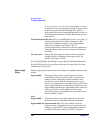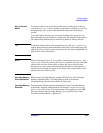
Managing Media
Formatting Media
Chapter 4108
Formatting Media
Wh at Is Form atting
Media?
Formatting media prepares them for use with Data Protector by saving
the information about the media (media IDs, description and location) in
the IDB, and also writes this information on the medium itself (medium
header). When you format media, you also specify to which media pool
the media belong.
NOTE Certain media management operations (initialize, scan, enter, and eject)
can be performed during backup or restore. Data Protector uses
“advisory locking” to ensure that a backup or restore will not fail if the
device cannot be locked. Other operations (backup, restore, import, and
copy) require device locking to proceed with backup or restore.
When to Format
Media
You need to format media before the media can be used for backup. If the
media are not formatted before backup and the Loose media allocation
policy is defined for the media pool, and the global variable
InitOnLoosePolicy is set to 1 (default is 0) Data Protector
automatically formats new media when they are selected for backup. In
this case, the media are labelled with default values.
Non-Data Protector media must be formatted before backup.
Recognition of
Other Formats
Data Protector recognizes common media formats, if the medium was
already in use. See “Recognizing Other Data Formats” on page 111 for
detailed information.
Formatting with
Padding Blocks
You can extend the size of the medium header and fill it up with
incompressible data, padding blocks. This becomes useful when creating
media copies. The padding blocks are not copied to the target medium.
This way you make sure that the target medium does not reach the end
of the tape before the source medium.
Tape padding is disabled by default. To enable it, set the
OB2BLKPADDING_n variable in the omnirc file on the system with the
backup device connected. For more information, see “Using Omnirc
Options” on page 525.


















